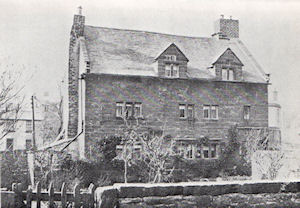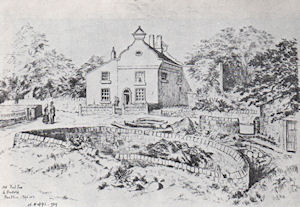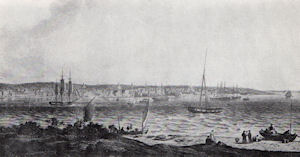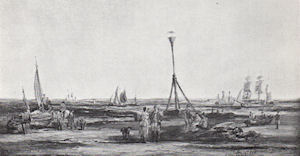Old Wallasey seen through the eyes of two distinguished historians
Almost 85 years ago saw the publication of a book which, to many Wallasey folk, has been a constant fireside companion and a valuable source of reference to a corner of the Wirral Peninsula rich in history and full of fascination.
The Rise and Progress of Wallasey (known to many as 'Woods & Brown', after its authors, E. Cuthbert Woods and P.C. Brown) was published in 1929 as 'an attempt to concentrate and focus the most important and least known facts into a readable form' - somewhat dry words for a volume brimful of superb reading and fine photos of Wallasey and its past. Just 500 copies were printed back in 1929, and such was its reception that it soon sold out, making it a collector's item today. It was not in print again until 1960, when a revised edition was published. This too was snapped up by an eager public; helped, of course, by the occasion of Wallasey's Jubilee celebrations that year. The latest edition was published in 1974 'to mark the passing of Wallasey as a Country Borough, on its incorporation into the Wirral Metropolitan District' (not, perhaps, an occasion worthy of celebration, many would say on reflection!). This edition was simply a reprint of the 1960 edition, with an extra chapter tacked on the end to take account of recent changes.
So, what was so special about The Rise and Progress of Wallasey? A glance at the Contents page gives some idea: The Ferries, Roads and Footpaths; Leasowe Castle; Mother Redcap's; Wrecking; Racing and, of course, the usual accounts of parochial and church history. Let us dip into the well-thumbed pages of the 1929 edition and see what gems Woods and Brown offered their readers.
Images of prehistoric man in Wallasey were conjured up early in the book by mention of the finding in 1864 if the human skeleton at Leasowe. Described by Sir Edward Cust of Leasowe Castle as 'The Prehistoric Man of Cheshire', Sir Charles Leyell later said 'The cranium was well formed but there was some peculiarities in it which indicated an original race or savage tribe.'
It is a long way from the days of prehistoric man to the following description of Wallasey Village as it was in the 18th century:
'A long straggling street, lined with cottages and small farmsteads, extending from below the parish church to the corner of the present Grove Road. Adjoining the houses on either side of the road were small crofts and closes. On the west these were divided by a lane, the Gutter, from the meadows sloping down towards a tributary of wallasey Pool which followed roughly the course of the railway from Green Lane to its junction with the line from Seacombe to Bidston. On the other side of this creek stretched the Pastures, near the Birket or Fender, and separated from the Leasowes by an ancient boundary fence, running approximately parallel to and midway between Green Lane and the present Leasowe Road, as far as New Hall or Leasowe Castle. The whole of the Leasowes and Pastures were until 1814 open and unenclosed, and common rights were appended to most of the tenements in the township. To the northward of a line following roughly to the course of Grove Road, Hoseside Road, Mount Pleasant Road to the Magazines, was an area of waste land, a rocky heath covered in part with blown sand from the shores of Liverpool Bay.' |
The story of the church of St. Hilary obviously occupies much space in the book, as does the history of Wallasey Grammar School; but skipping these pages we quickly come to a petition presented by the householders of Seacombe which indicates that rural life 150 years ago was not quite so idyllic as it often made out:
'We the undersigned householders...beg to call your attention to the inefficient state of the sewage and drainage...of Seacombe. We have to observe that all the drains and sewers from the houses and water closets of the village of Seacombe deposit their filthy contents upon the shore (of Wallasey Pool), the stench from which is not only highly offensive to the senses but extremely prejudicial to health. Before a certain embankment was raised, the tidal waters of the River Mersey washed the before-mentioned shore daily, and consequently removed all impurities; that the said tide is now excluded, and that a cesspool is formed within the said embankment, which engenders malaria, and will in the coming hot season be a fruitful source of fever and disease to a neighbourhood already notorious for its unhealthiness.' |
Many Wallaseyans remember the old green buses; and the legend of the origin of their colour appears in the 1929 book: 'The colour chosen for the electric cars is said to have arisen in the following manner. When the contact for the cars was accepted, the question was asked, what colour the cars should be painted. It was decided to leave it to the Manager, (a Major R R Greene), and the reply was 'O! see Greene'. And 'sea green' they are to this day!'
 |
 |
Bird's House |
Old Pool Inn & Pinfold, 1919 |
The history and development of Wallasey's ferries occupies a long chapter, richly adorned with line drawings of some of the boats.
'The ferry boats used appear at first to have been single-master, little larger than the lifeboats now carried on the stern of their successors. Later two-masted boats, or grabs, were used. Landing too was a simple matter, passengers wading or doubtless some being carried ashore through the shallows. A primitive gangway is described as consisting of a plank supported on two large wheels. It is interesting to note that the price if a saddle horse in this part of the world was then materially affected by its ability to jump out of a ferry boat cleanly and land its rider safely on terra firma'!
One of the most fascinating sections is devoted to the origins and early descriptions of Wallasey's old footpaths and by-laws. Here are insights into ancient Wallasey: Guinea Gap, named after the finding of William III guineas and a sword in the sand; Cinder Lane, 'a beautiful walk in the days before the conversion of the Pool into docks, when the green fields sloped down to the water on either side of the Pool along the banks of which the path ran, crossing the several creeks by small wooden bridges. 'Many of the roads were derived from old field-names: 'At the west corner (of Stringhey Road) where it is joined by Marsden Road, was the village well with its pump which was the rendezvous where the young men of the parish who went to sea used to tell stories of their adventures and travels.'
 |
 |
Seacombe Foreshaw, 1817 |
The Perch Rock |
Mills, inns, cottages, pinfold's, farms, halls, diaries - all are mentioned and described in detail, and a whole chapter is devoted to Leasowe Castle and the notorious Mother Redcap's.
'It was at Wallasey that the first Gentlemen Racecourse in the kingdom was established.' Thus begun the chapter on racing at Wallasey; and the final chapter is devoted to the Journal of John Hough, churchwarden at Wallasey in the 1700s. This is a superb record of Wallasey life at that time, and deserves an article on its own right.
Aug 19th, 1756: Jonathan Deane's hound worried a sheep on the Leasowe marked thus - the left ear cut close to the head, & the right ear slit; it was a black & white sheep with a black belly & black legs. Jonathan's son was at the mill the same day Sept 2nd, 1758: Being Saturday night, Margaret Tyrer & her maid abused me, & took my wig off my head & put it in the fire and Saml. Pemberton took it out of the fire. |
Sadly E.C Woods and P.c. Brown are both dead; however, their painstaking survey of Wallasey and its past has given endless pleasure to thousands of Wirral folk for nearly 85 years. A copy of the book is available at Earlston Library for loaning.
Featured sites
- Non Gamstop Casinos
- Casino Not On Gamstop
- UK Casinos Not On Gamstop
- Non Gamstop Casinos UK
- Sites Not On Gamstop
- Sites Not On Gamstop
- Casinos Not On Gamstop
- Casinos Not On Gamstop
- Casinos Not On Gamstop
- Non Gamstop Casino UK
- Casinos Not On Gamstop
- Non Gamstop Casino
- UK Online Casinos Not On Gamstop
- UK Online Casinos Not On Gamstop
- Non Gamstop Casinos
- Casino Sites Not On Gamstop
- Casinos Not On Gamstop
- Casinos Not On Gamstop
- Best Betting Sites
- Casinos Not On Gamstop
- Gambling Sites Not On Gamstop
- Betting Sites That Are Not On Gamstop
- Non Gamstop Casinos UK
- UK Online Casinos Not On Gamstop